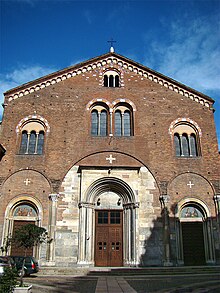Basilica of San Simpliciano
| Basilica of Saint Simplician Basilica di San Simpliciano |
|
|---|---|

Façade of San Simpliciano.
|
|
| Basic information | |
| Location | Milan, Italy |
| Geographic coordinates | 45°28′26″N 9°11′04″E / 45.473888°N 9.184474°E |
| Affiliation | Roman Catholic |
| Rite | Ambrosian Rite |
| Country | Italy |
| Year consecrated | 3rd-century |
| Status | Active |
| Website | www |
| Architectural description | |
| Architectural type | Church |
| Architectural style | Latin cross plan, with a four-bay nave and two aisles. |
The Basilica of San Simpliciano is a church in the centre of Milan, Italy northern, the second oldest in the form of a Latin cross, first erected by Saint Ambrose. It is dedicated to Saint Simplician, bishop of Milan.
The site of the present church was occupied in the 3rd century AD by a pagan cemetery. There St. Ambrose began the construction of the Basilica Virginum ("Basilica of the Virgins"), which was finished by his successor Simplicianus, who was buried there. A brick with the mark of the Lombard King Agilulf shows that repairs were made between 590 and 615 AD.
In the ninth century the Cluniac Benedictines took possession of the church. In 1176 the church became famous when, according to the legend, the bodies of the martyrs housed here flew as doves to the field of Legnano, landing on the City's Carroccio, (a ceremonial war waggon) as a sign of the imminent victory against Frederick Barbarossa's army.
When the building was modified between the 12th and the 13th centuries, giving it the present Romanesque appearance, the original walls were preserved to a height of 22 meters. On the night of 6–7 April 1252 the body of Peter of Verona (later St. Peter Martyr) lay in state after his assassination. A great multitude came to watch vigil, and the origins of Peter's cult began, as people started to report miraculous occurrences. In 1517 it was acquired by the Benedictines of Montecassino, who remained here until 1798, when the convent was secularized and for a time turned into barracks. In the 16th century the Spanish governor Ferrante Gonzaga had the bell tower lowered by 25 meters. The dome and the side wings were also modified in 1582. Other interventions were carried out in the 19th century, with poor results, while the façade was reworked in 1870. In 1927 stained-glass windows portraying episodes of the battle of Legnano were added.
...
Wikipedia
